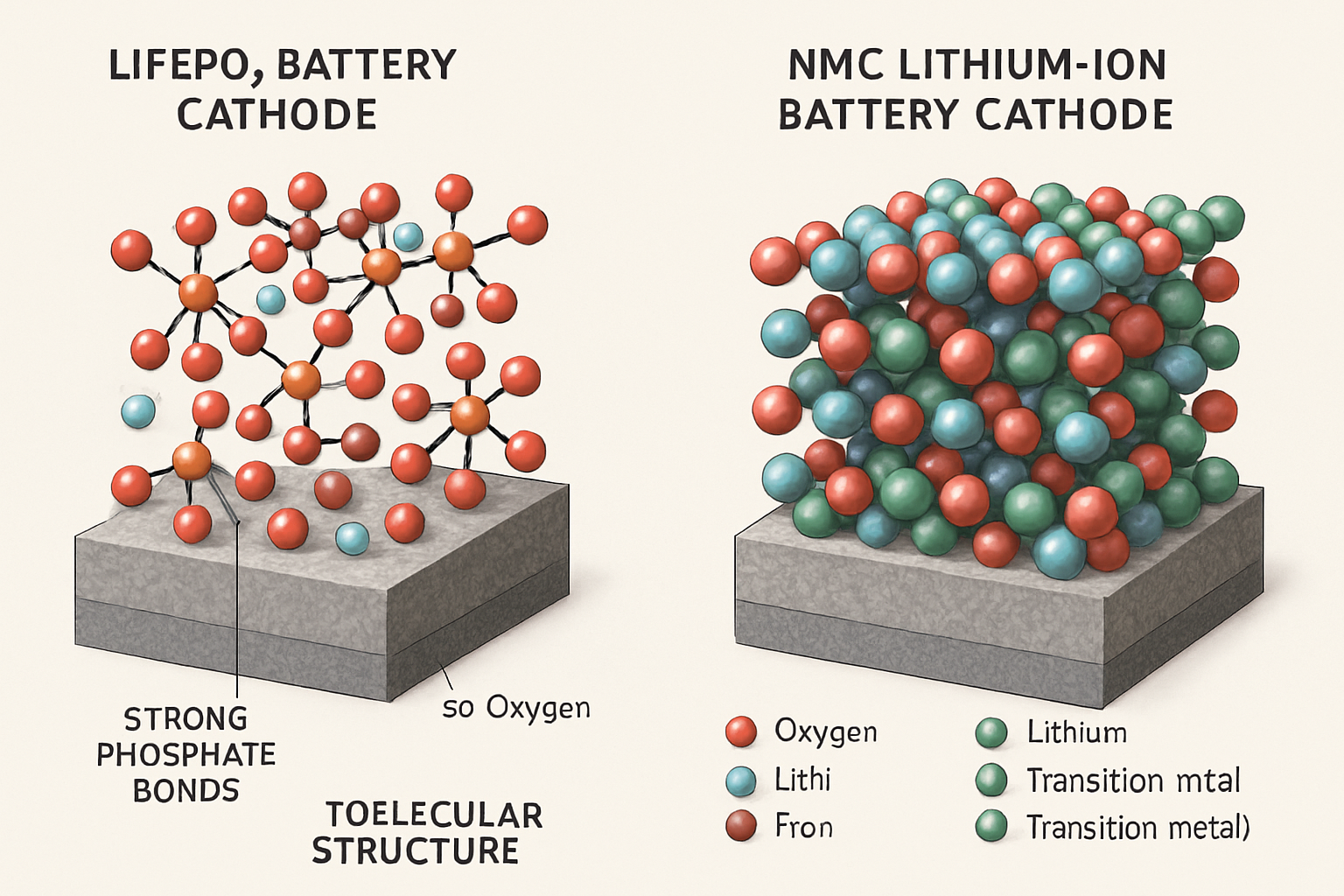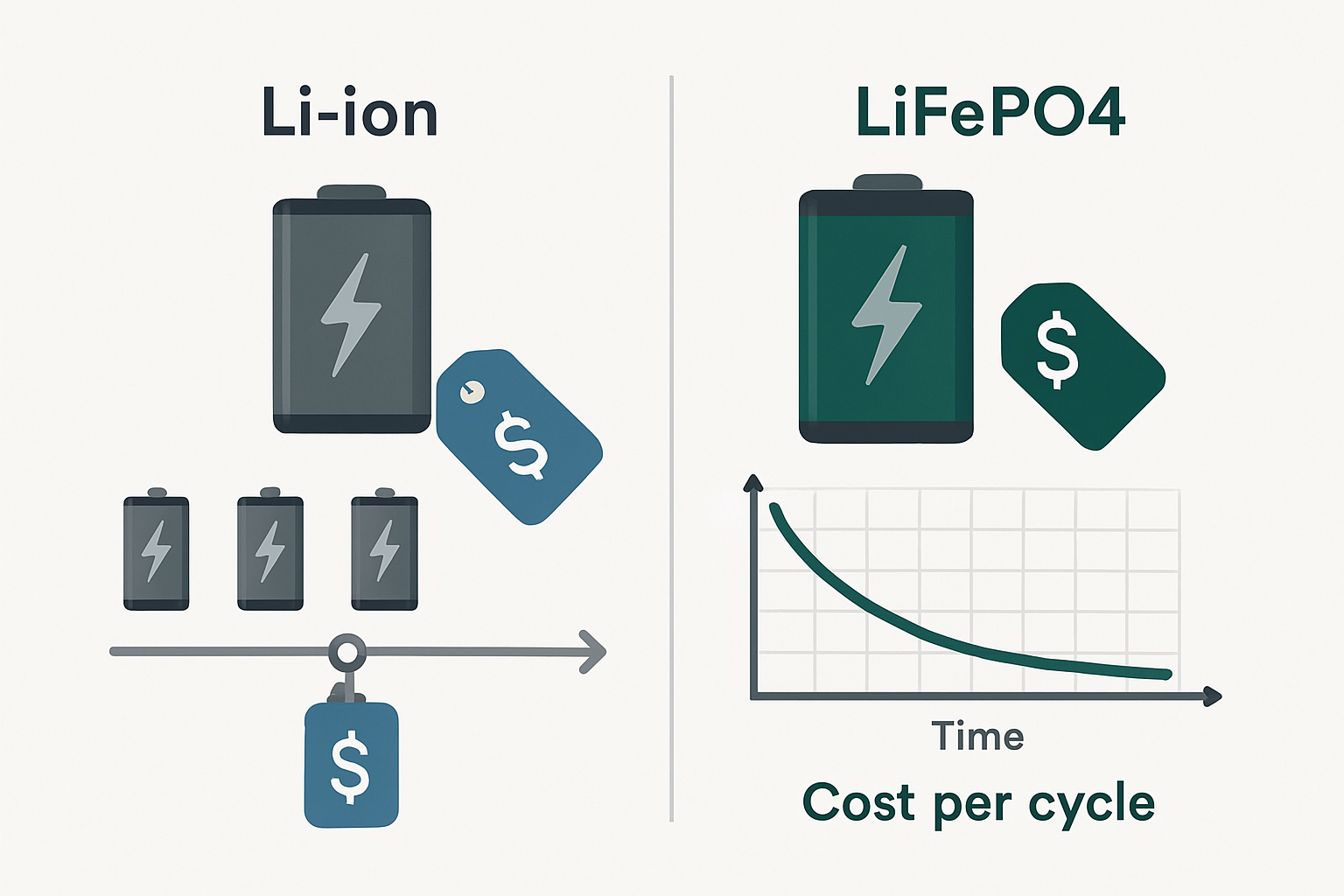The conversation around energy storage often groups all lithium batteries under one umbrella. This generalization creates confusion and fuels myths that can lead to poor decisions. Understanding the distinct battery chemistry differences, particularly LiFePO4 versus Li-Ion types like NMC or LCO, is crucial for building a reliable and safe energy system. This analysis separates fiction from fact, providing a clear view of performance realities.
Myth 1: All Lithium-Ion Batteries Are Fundamentally the Same
A common misconception is that the term 'lithium-ion' describes a single technology. In reality, it is a family of batteries, each with a unique chemical composition and performance profile. The choice of materials, especially for the cathode, dramatically alters the battery's characteristics.
Understanding the Chemical Divide: LiFePO4 vs. NMC
Lithium Iron Phosphate (LiFePO4) batteries use a cathode made from lithium iron phosphate, a remarkably stable compound. Its olivine crystal structure is robust and does not break down easily under stress, which contributes to its safety and longevity. In contrast, other lithium-ion batteries, such as Nickel Manganese Cobalt (NMC), use metal oxides. While these chemistries can store more energy in a smaller space, their layered structures are less stable. According to the International Energy Agency (IEA), the diversity in battery chemistries allows for tailored solutions across different sectors, from electric vehicles to stationary storage.
Impact on Real-World Applications
These chemical distinctions directly influence how the batteries perform in specific applications. For stationary home energy storage, where safety, a long lifespan, and reliability are paramount, LiFePO4 is an excellent choice. Its chemical stability makes it far less susceptible to thermal runaway. NMC batteries are often preferred for portable electronics and electric vehicles, where maximizing energy in a limited space is the primary goal. The trade-off is often a shorter cycle life and more complex thermal management requirements.
Myth 2: Higher Energy Density Always Equals Better Performance
The pursuit of higher energy density—the amount of energy stored per unit of weight (Wh/kg)—is relentless. While it is a critical metric for portable devices, it is not the most important factor for stationary energy storage. Prioritizing energy density above all else ignores crucial trade-offs in safety, stability, and longevity.
The Relationship Between Energy Density and Stability
NMC and other high-density lithium-ion chemistries achieve their capacity through chemical structures that are inherently more volatile. LiFePO4 chemistry prioritizes stability. This results in a lower energy density but a significantly higher safety threshold. A LiFePO4 cell's thermal runaway point is around 270°C (518°F), whereas an NMC cell can enter thermal runaway at temperatures as low as 150°C (302°F). This superior thermal stability provides a vital safety margin for systems installed in homes or businesses.
Why Stability Outweighs Density for Solar Storage
For a home battery, the goal is to store solar energy reliably for a decade or more. The system must withstand daily charge and discharge cycles without degradation or safety concerns. A detailed look at solar storage performance metrics reveals that cycle life, depth of discharge (DoD), and operational temperature range are far more critical than raw energy density. LiFePO4 excels in these areas, delivering consistent output for thousands of cycles, making it a more practical and dependable long-term solution.
Myth 3: The Upfront Cost Is the Only Financial Factor
Focusing solely on the initial purchase price is a shortsighted approach to evaluating battery value. A true assessment requires calculating the Total Cost of Ownership (TCO), which accounts for the battery's lifespan, performance, and replacement frequency.
Calculating the Total Cost of Ownership (TCO)
TCO provides a more complete financial picture. A cheaper battery that needs to be replaced two or three times will ultimately cost more than a durable battery with a higher initial price. Key factors in TCO for a battery include its cycle life, round-trip efficiency, and the cost per kilowatt-hour over its entire operational life. As noted by the U.S. Department of Energy, extending the lifespan of energy storage systems is critical to reducing long-term costs and enhancing grid reliability.
LiFePO4's Long-Term Value Proposition
LiFePO4 batteries deliver a significantly lower TCO due to their exceptional cycle life. They can typically endure between 4,000 and 8,000 deep discharge cycles while retaining a high percentage of their original capacity. Many other lithium-ion types offer only 500 to 1,500 cycles. This durability means a LiFePO4 battery can last over a decade in a typical solar storage application, eliminating replacement costs and delivering superior long-term value.
| Feature | LiFePO4 Battery | NMC Battery (Typical) |
|---|---|---|
| Average Cycle Life (at 80% DoD) | 4,000 - 8,000+ cycles | 1,000 - 2,000 cycles |
| Thermal Runaway Temperature | ~270°C (518°F) | ~150°C (302°F) |
| Nominal Cell Voltage | 3.2V | 3.6V / 3.7V |
| Safety Profile | Excellent | Good (Requires advanced BMS) |
| Total Cost of Ownership | Lower | Higher (due to shorter lifespan) |
A Clearer Path to Energy Independence
Debunking these common myths reveals a clear distinction between battery chemistries. LiFePO4 and energy-dense li-ion batteries are not interchangeable; they are engineered for different purposes. For solar and energy storage systems, where the priorities are safety, a long service life, and stable performance, Lithium Iron Phosphate performance facts speak for themselves. Making a choice based on a comprehensive understanding of battery chemistry differences ensures you build a system that is not only effective but also cost-efficient and reliable for years to come.
Disclaimer: The information provided is for educational purposes only and does not constitute financial or investment advice. Consult with a qualified professional before making any decisions related to your energy system.
Frequently Asked Questions
Is LiFePO4 the same as a lithium-ion battery?
No. LiFePO4 (Lithium Iron Phosphate) is a specific type of lithium-ion battery. The term 'lithium-ion' refers to a broad family of batteries with different chemistries, including LiFePO4, NMC (Nickel Manganese Cobalt), and LCO (Lithium Cobalt Oxide).
Why is LiFePO4 considered safer?
Its safety comes from its stable chemical structure. The phosphate-based cathode is less prone to overheating and thermal runaway, even if punctured or overcharged, compared to the metal-oxide cathodes in other lithium-ion types.
Can I use any lithium-ion battery for my solar panel system?
While technically possible, it is not recommended. Batteries designed for solar energy storage, like deep-cycle LiFePO4 models, are built for long-term, repeated charging and discharging. Using a battery not designed for this purpose can result in poor performance, a shorter lifespan, and potential safety hazards.





Leave a comment
All comments are moderated before being published.
This site is protected by hCaptcha and the hCaptcha Privacy Policy and Terms of Service apply.